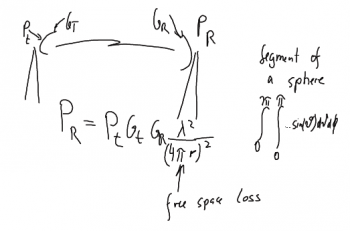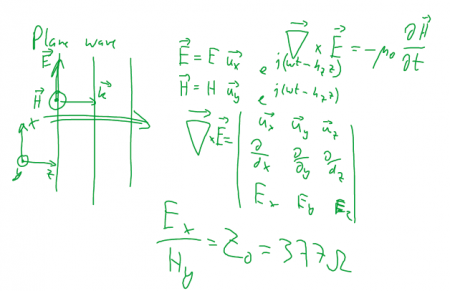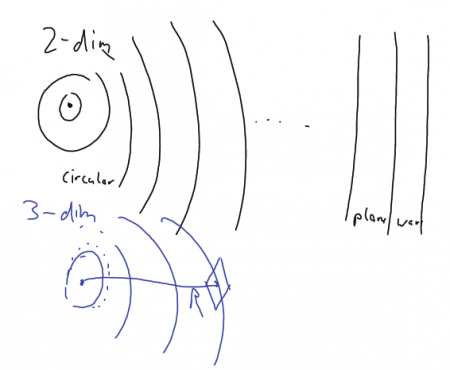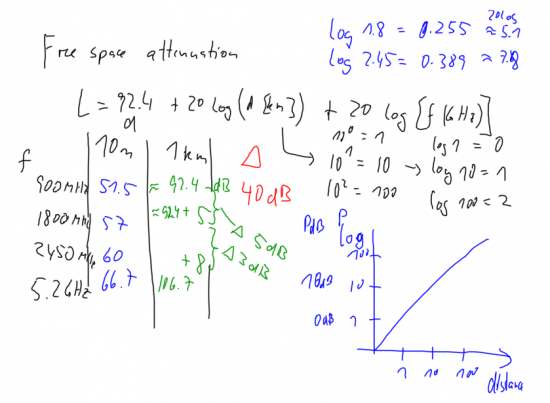Difference between revisions of "B1-Free Space Propagation"
Josef.Noll (Talk | contribs) |
Josef.Noll (Talk | contribs) (→⌘ Task: Plane wave propagation) |
||
| Line 72: | Line 72: | ||
* a wave looking like a "cylinder" is called a cylindrical wave. Such a wave is typically generated by a line source, or the diffraction at the edge of a roof | * a wave looking like a "cylinder" is called a cylindrical wave. Such a wave is typically generated by a line source, or the diffraction at the edge of a roof | ||
* a wave looking like a "ball" is called a spherical wave. Such a wave is typically generated by a point source, e.g. a short antenna. If you move long away from the wave, then the spherical wave will become a plane wave. We talk about the ''far-field'' of an antenna, when the wave is treated like a plane wave. This is typically expressed as a phase variation being less than 90 degrees: <math> \varphi < 90\deg </math> | * a wave looking like a "ball" is called a spherical wave. Such a wave is typically generated by a point source, e.g. a short antenna. If you move long away from the wave, then the spherical wave will become a plane wave. We talk about the ''far-field'' of an antenna, when the wave is treated like a plane wave. This is typically expressed as a phase variation being less than 90 degrees: <math> \varphi < 90\deg </math> | ||
| − | |||
| − | + | === Comments and further reading === | |
| − | + | ||
| − | + | ||
| − | + | ||
| − | = | + | |
Q: I still don't understand the propagation equation | Q: I still don't understand the propagation equation | ||
| − | :A: | + | :A: The propagation equation describes how a wave propagates. It addresses the change from an electrical field indicating a magnetic field and vice versa. See the video from Bucknell University: https://www.youtube.com/watch?v=xkG86pwaOH0 |
==⌘ Free space propagation == | ==⌘ Free space propagation == | ||
| − | |||
| − | |||
Power received in an area in a distance R from transmitter: | Power received in an area in a distance R from transmitter: | ||
| Line 103: | Line 96: | ||
* <span style="color:#000B80"> provide examples for f = 10 MHz, 1 GHz, 100 GHz</span> | * <span style="color:#000B80"> provide examples for f = 10 MHz, 1 GHz, 100 GHz</span> | ||
* <span style="color:#000B80"> discuss influences on radiation pattern</span> | * <span style="color:#000B80"> discuss influences on radiation pattern</span> | ||
| + | |||
| + | ===⌘ Tasks === | ||
| + | <span style="color:#000B80"> Develop the propagation equation</span>, see (http://www.antenna-theory.com/basics/friis.php) | ||
| + | |||
'''How much is 0 dB_m and 10 dB_m?''' | '''How much is 0 dB_m and 10 dB_m?''' | ||
| Line 116: | Line 113: | ||
<math>L = 92,4 + 20 \log(d \mathrm{[km]}) + 20 \log(f \mathrm{[/GHz]}) </math> | <math>L = 92,4 + 20 \log(d \mathrm{[km]}) + 20 \log(f \mathrm{[/GHz]}) </math> | ||
| − | === | + | === Comments === |
{| | {| | ||
|[[File:f3-11.png|350px]] | |[[File:f3-11.png|350px]] | ||
Revision as of 21:48, 10 October 2015
| Wiki for ITS | ||||||
|---|---|---|---|---|---|---|
|
Contents
⌘ Maxwell's Equation in a source free environment
Source free environment and free space:
where div is a scalar function
and curl is a vector function
[Source: Wikipedia]
⌘ Wave equation
Taking the curl of Maxwell's equation
yields the wave equation:
with m/s
[Source: Wikipedia]
⌘ Homogeneous electromagnetic wave
A single frequency electro (E)-magnetic (B) wave is described by
,
,
[Source: Wikipedia]
where
-
and
so?
-
is the imaginary unit
-
is the angular frequency, [rad/s]
-
is the frequency [1/s]
-
is Euler's formula
with the group velocity (free space = speed of light) and the refraction index
⌘ Tasks
- What is the difference between a static and a dynamic field
- Develop the relations for a plain wave
- Assume a plane wave:
. Show that
Comments
The differences between a plane wave, a cylindrical wave and a spherical wave is defined through the surface of wave. Assume propagation in z-direction
- a wave having no variation in x,y direction is called a plane wave, and is represented as e.g.
,
- a wave looking like a "cylinder" is called a cylindrical wave. Such a wave is typically generated by a line source, or the diffraction at the edge of a roof
- a wave looking like a "ball" is called a spherical wave. Such a wave is typically generated by a point source, e.g. a short antenna. If you move long away from the wave, then the spherical wave will become a plane wave. We talk about the far-field of an antenna, when the wave is treated like a plane wave. This is typically expressed as a phase variation being less than 90 degrees:
Comments and further reading
Q: I still don't understand the propagation equation
- A: The propagation equation describes how a wave propagates. It addresses the change from an electrical field indicating a magnetic field and vice versa. See the video from Bucknell University: https://www.youtube.com/watch?v=xkG86pwaOH0
⌘ Free space propagation
Power received in an area in a distance R from transmitter:
- area of a sphere is
- power transmitted from isotropic antenna is
- antenna area of receiver is
- power received in A_r = P_r
thus
- convert into dB
- provide examples for f = 10 MHz, 1 GHz, 100 GHz
- discuss influences on radiation pattern
⌘ Tasks
Develop the propagation equation, see (http://www.antenna-theory.com/basics/friis.php)
How much is 0 dB_m and 10 dB_m?
- Convert dBm to mW is: mW = 10^(x/10), x = number of dBm
- Convert mW to dBm is: dBm = 10*log10(y), y = number of mW
So you get:
- 0 dBm = 10^(0/10) = 1 mW
- 10 dBm = 10^(10/10) = 10 mW
Free space attenuation
Comments

|
Free space propagation from a transmit (t) to a receive (r) station. |
Calculation of free space attenuation. Note the increased free-space attenuation of approx 5 dB from 900 to 1800 Unik/MHz, and a further increase of 3 dB from 1800 (GSM 1800) to 2450 Unik/MHz (802.11b). Note also that increasing the distance by a factor of 10 will increase the power requirements by 20 dB.
Have in mind that normal communication is always worse than the "ideal" free space communication. You have shadowing, reflections, interference, and other influences increasing the path loss. An example is the Bluetooth communication between your mobile phone and your headset, where your body absorbs energy and shadows for direct communication.
Free space propagation Calculation: http://spreadsheets.google.com/pub?key=p0EyjWrbirGKJXK43uluJfg


